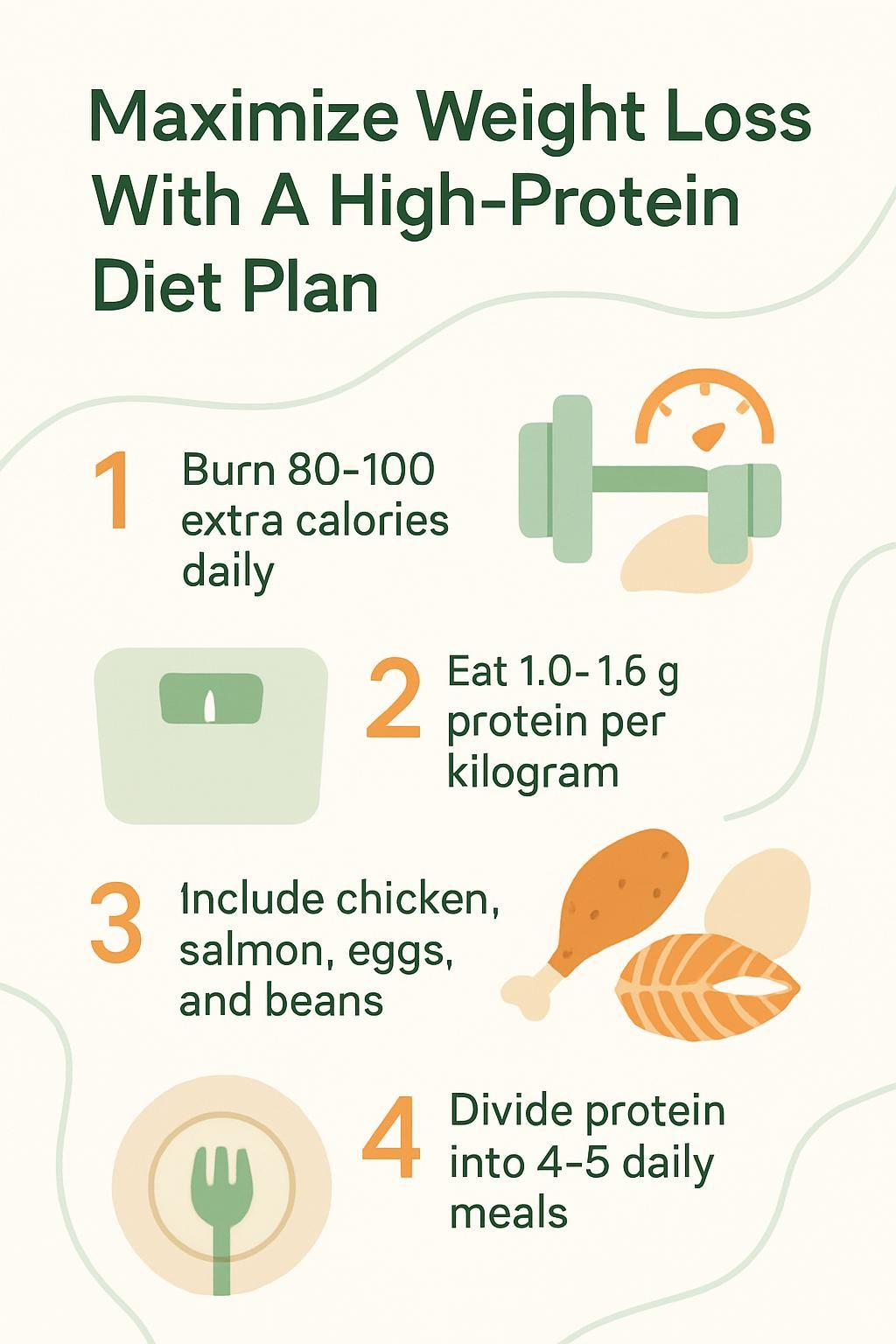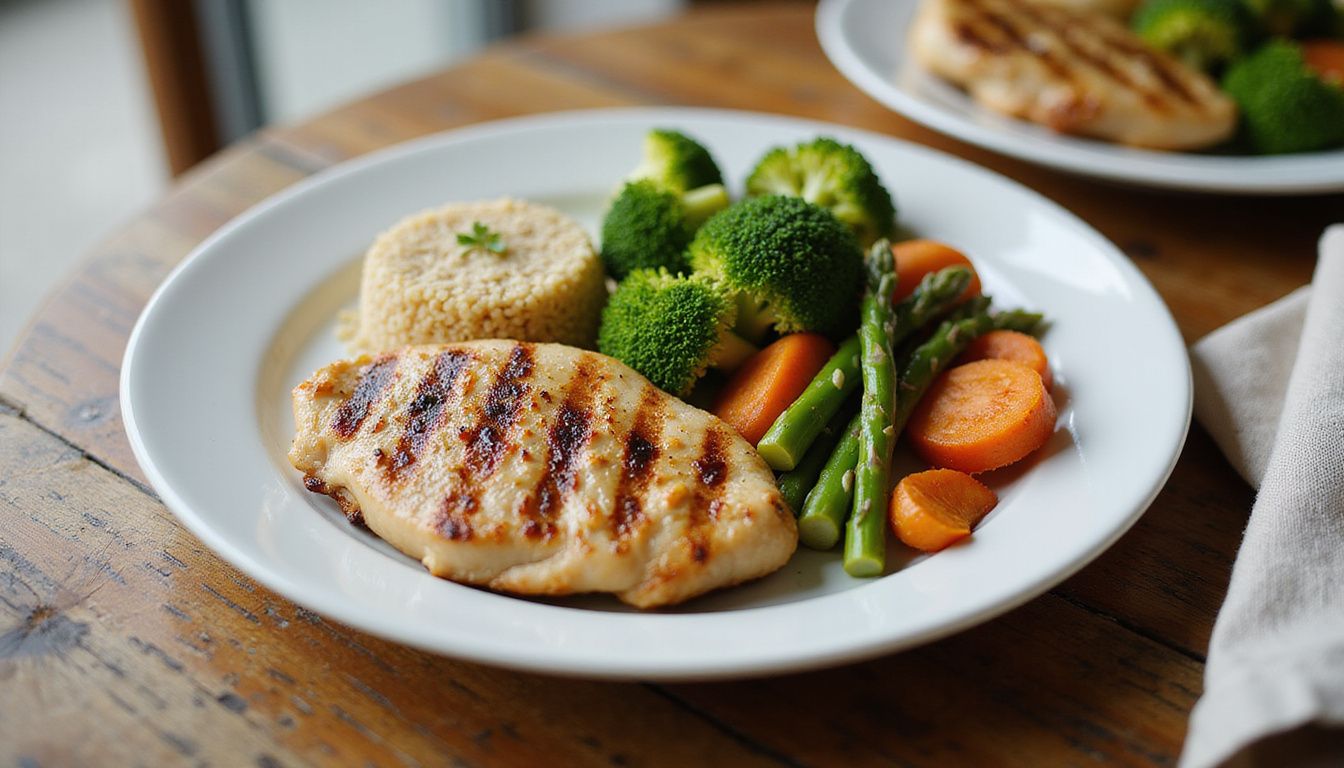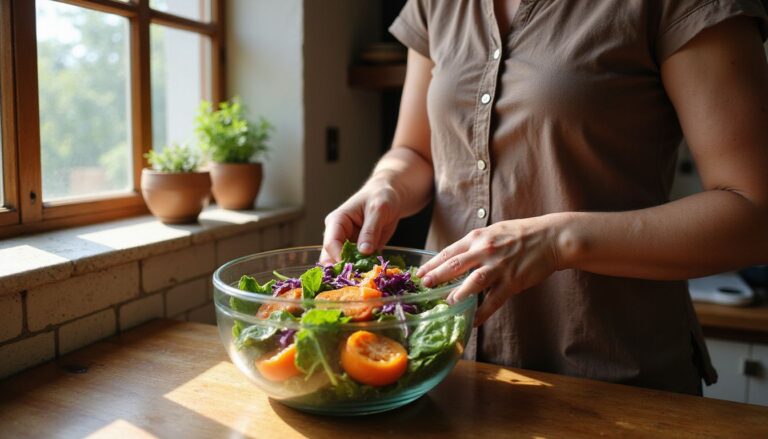Maximize Weight Loss With A High-Protein Diet Plan
Our Nutrition Assistant AI Suite will transform your body. You will lose fat, get toned, and build muscle. Gain confidence and optimal health.
You try to lose weight, yet hunger and slow progress can sap your energy. A high-protein diet can help you control appetite, protect muscle, and support steady fat loss. Research shows that eating more protein raises daily calorie burn and keeps you fuller between meals.
This guide shows you how to eat more protein with smart food choices and a simple meal plan. You will learn what to eat, how much protein you need, and how to avoid common pitfalls. Small changes can move you toward a healthy weight and better energy faster.
Key Takeaways
- Higher protein increases daily calorie burn by about 80 to 100 calories and helps you keep muscle during weight loss, based on studies in the American Journal of Clinical Nutrition.
- Aim for 1.0 to 1.6 grams of protein per kilogram of body weight each day. This range improves fullness, reduces hunger, and limits muscle loss in clinical trials.
- Top protein picks: skinless chicken breast, salmon, tuna, eggs, Greek yogurt, low-fat cottage cheese, tofu, beans, and protein powders.
- Very high protein without enough fiber can cause constipation and nutrient gaps. Drink water, and include fruits, vegetables, and whole grains.
- Spread protein across four or five meals or snacks. Regular protein helps curb cravings and supports long-term weight management.

Why Protein Matters for Weight Loss

Protein does heavy lifting for your body. It tames hunger, protects muscle, and supports a faster metabolism, which is the energy you burn at rest.
How does protein affect metabolism?
Protein raises your metabolism through the thermic effect of food, which is the energy your body uses to digest and process food. You burn about 20 to 30 percent of the calories from protein just to break it down. Carbohydrates use about 5 to 10 percent, and fats use about 0 to 3 percent.
People who increase protein to roughly 1.2 to 1.6 grams per kilogram of body weight often burn more calories, even when resting. That small daily boost can add up over weeks and months. Protein also supports tissue repair and recovery after workouts or injuries.
A higher protein diet raises resting metabolic rate, helping you burn an extra 80 to 100 calories per day, American Journal of Clinical Nutrition.
This rise in calorie burn pairs well with protein’s ability to control appetite.
How does protein influence appetite and fullness?
Protein increases peptide YY, a fullness hormone, and lowers ghrelin, the hunger hormone. In clinical studies, getting 25 to 30 percent of calories from protein led people to eat fewer calories later in the day. A protein-rich breakfast with eggs or Greek yogurt often reduces mid-morning snacking.
Dividing protein into four to five meals or snacks steadies energy and appetite. Because protein takes more effort to digest, your body spends extra calories processing it. In my own routine, a higher protein breakfast and an afternoon Greek yogurt cut late-night cravings and made it easier to stick to my plan.
Better fullness also protects your muscles, which keeps your metabolism higher during weight loss.
Why is protein important for preserving muscle during weight loss?
When you eat fewer calories, your body can break down both fat and muscle for energy. Adequate protein limits muscle loss, which is called muscle atrophy. Studies suggest 1.0 to 1.2 grams per kilogram of body weight per day supports muscle while you lose fat. For a 175 pound person, that is about 80 to 95 grams per day.
Stronger muscles help you feel energetic and keep your metabolism higher. If protein is too low, you may feel weak, tire easily, or notice poorer performance during exercise. Choosing lean, high-protein foods makes it easier to maintain a healthy weight after you reach your goal.
Benefits of Following a High-Protein Diet
Eating more protein supports weight control in several ways. It boosts calorie burn, improves fullness, and helps you keep lean mass while dropping fat mass.
How does a high-protein diet increase calorie burn?
Protein has the highest thermic effect among the three macronutrients. Your body spends more energy digesting it, so you burn more calories after protein-heavy meals. People who eat about 1.2 to 1.6 grams of protein per kilogram of body weight per day often see a measurable increase in daily calorie use.
Include a protein source at every meal, such as chicken, fish, eggs, Greek yogurt, or beans. Many people notice steadier energy and less afternoon fatigue when they add a protein-rich snack like cottage cheese or a small shake.
Keeping metabolism a little higher after initial weight loss may also help you avoid weight regain. A steady protein habit can be your safety net.
Can a high-protein diet reduce cravings and hunger?
Yes. Protein slows digestion and supports hormones that signal fullness. In studies, people who increased daily protein often ate up to several hundred fewer calories without trying. That happens because protein makes meals more satisfying.
Practical options include eggs, fish, dairy, beans, lentils, nuts, and whey or plant-based protein powders. If you aim for roughly 1 gram of protein per pound of body weight, you may notice fewer sugary snack urges in the afternoon. Many see the biggest changes around belly fat, which tends to respond to better appetite control and higher protein intake.
How does protein improve body composition?
Body composition is the balance of lean mass and fat mass. Protein supports muscle protein synthesis, which is the building and repair of muscle tissue. Diets higher in protein help you lose more fat while holding onto more lean mass.
For a person around 175 pounds, a daily intake near 80 to 95 grams often supports favorable changes while dieting. More lean mass means you burn more calories at rest. Adequate protein also helps prevent the rebound of fat after dieting since it helps control appetite and supports steady energy.
What is the effect of protein on blood sugar control?
Protein slows the release of glucose from a meal, which can prevent sharp spikes in blood sugar. Pairing protein with fiber, such as vegetables or beans, improves that effect. Many people feel steadier energy and fewer afternoon crashes when they add protein to each meal.
Experts note that higher protein, combined with balanced carbs and regular activity like walking or strength training, can support healthy insulin responses and blood pressure. Below is a simple summary from clinical data in adults at risk for type 2 diabetes.
| Diet Type | % Change in Fasting Glucose | Blood Pressure Impact |
|---|---|---|
| Low-Protein | +5% | No improvement |
| High-Protein | -10% | Lower systolic |
Simple swaps help. Add grilled salmon, eggs, or lentils to your meals to support weight loss and more stable blood sugars.
How Much Protein Should You Eat?
Your target depends on your body size, goals, and activity level. Getting the right amount helps you lose fat while keeping muscle.
What is the recommended daily protein intake?
The minimum recommendation is 0.8 grams of protein per kilogram of body weight per day. If you weigh 175 pounds, or about 79 kilograms, that is around 64 grams per day. Many people need more for weight loss or muscle retention.
The National Academy of Medicine suggests 10 to 35 percent of daily calories from protein. On a 2,000 calorie plan, that equals 200 to 700 calories from protein. For weight loss or muscle support, many experts target 20 to 30 percent of calories from protein.
A higher protein range can help you stay full, protect lean mass, and stick to your plan while you cut calories.
How to adjust protein intake for weight loss goals?
Use a simple, step-by-step approach that fits your schedule and appetite.
- Start at 1.0 to 1.2 grams of protein per kilogram of body weight. For 175 pounds, that is roughly 80 to 95 grams per day.
- Try the 90-30-50 method: target 90 grams of protein, 30 grams of fiber, and 50 grams of healthy fats daily.
- Include protein at every meal and snack to steady appetite and calories.
- Use protein powder if hitting 70 grams per day is hard with food alone.
- Pick lean, high-protein foods: chicken breast, fish, eggs, Greek yogurt, tofu, beans, and nut butters in small amounts.
- Track your intake with a food diary or app to spot gaps and patterns.
- Increase protein slightly during heavy training or when building muscle.
- Check with a clinician if you have kidney disease or concerns about cholesterol.
- Watch for signs of imbalance such as headache, constipation, bad breath, or fatigue. Adjust portions and add fiber and fluids.
- Many people find that adding both plant and animal proteins cuts hunger and helps them stay consistent during a calorie deficit.
This framework supports fat loss while protecting muscle, which improves the odds you will keep the weight off.
What factors influence protein needs (age, activity, etc.)?
Several factors change how much protein you need. Age matters because muscle tends to decline with time, a process called sarcopenia. Older adults often benefit from higher protein per pound of body weight.
Activity level also raises protein needs. Hard training breaks down muscle fibers, so you need extra amino acids, which are the building blocks of protein, for repair. Pregnancy raises needs to support a growing baby. Recovery from injury can increase needs as well.
During marathon training last year, I felt stronger when I increased lean protein from eggs and chicken. If you have kidney issues, avoid very high intakes such as more than 2 grams per kilogram per day unless your doctor advises it. A quick conversation with your clinician helps you set a safe, effective target.
Top High-Protein Foods for Weight Loss
Build your plate around foods high in protein. Mix animal and plant options to improve variety, taste, and nutrition.
What lean meats are best for protein?
Skinless chicken breast is a classic choice, with around 26 grams of protein in 3 ounces. Turkey breast provides similar protein with little saturated fat. Choose red meat cuts labeled loin or round, such as sirloin tip or eye of round, to keep saturated fat lower.
Pork tenderloin is another lean option with solid protein per serving. These choices help protect your heart while supporting muscle during a calorie deficit.
Which fish and seafood are high in protein?
Most fish provide about 17 to 20 grams of protein per 3 ounce serving. Salmon, tuna, trout, and cod are reliable picks. Shrimp and crab are also high in protein with very little saturated fat.
Swapping some red meat for seafood can lower LDL cholesterol, which is the less healthy type, and support heart and bone health. Aim for seafood twice a week if you can.
What eggs and dairy products are good protein sources?
Low-fat cottage cheese stands out, with about 12 grams of protein per half cup. A large egg offers 6 grams and is very filling. Greek yogurt brings protein plus probiotics, which support gut health.
Low-fat milk, reduced-fat cheeses, and kefir can help you reach your daily total. Pair dairy with fruit or whole grain crackers to add fiber.
What are the best plant-based proteins for weight loss?
Plant proteins can help you lose weight while adding fiber and key minerals. Firm tofu has about 9 grams in 3 ounces. Half a cup of cooked lentils provides about 9 grams. Kidney beans offer around 8 grams in the same portion.
Almonds supply 6 grams per ounce, and two tablespoons of peanut or almond butter have about 7 grams. Other strong choices include tempeh, edamame, quinoa, chickpeas, pistachios, chia seeds, pumpkin seeds, and even peas. These foods increase fullness and support a steady calorie intake.
Should you use protein supplements? Which types?
Supplements can help on busy days or after workouts. Whey and casein come from dairy and are easy to mix into shakes. Soy and pea protein are good options if you prefer plant-based powders.
Choose products low in added sugar and saturated fat. If you have a medical condition or take medications, talk with a healthcare professional or a registered dietitian first. Supplements work best as a helper, not a replacement for whole foods.
Sample High-Protein Meal Plan
A simple plan makes daily choices easier. Use these ideas to build meals that fit your taste and schedule.
What is a healthy high-protein breakfast?
Try oatmeal topped with Greek yogurt and berries for about 20 grams of protein. Eggs with whole grain toast and sliced avocado are another filling option. Both choices support appetite control and preserve muscle during weight loss.
People who start with a protein-rich breakfast often snack less and feel more focused through the morning.
What does a high-protein lunch look like?
Base your lunch on a lean protein plus fiber and healthy fats. A grilled chicken salad with leafy greens, tomatoes, cucumbers, almonds, and olive oil dressing delivers about 30 grams of protein and stays satisfying for hours.
Other ideas include salmon with quinoa and roasted vegetables, or a turkey and bean bowl with salsa and avocado. These meals help maintain muscle while you target body fat.
How to prepare a high-protein dinner?
Pick a protein centerpiece, then add vegetables and a smart carb. A 4 ounce salmon fillet has around 23 grams of protein and offers omega-3 fats that support heart health. Pair it with steamed broccoli and a side of quinoa, which adds extra protein and all nine essential amino acids.
Stir-fries with tofu or shrimp and mixed vegetables also work well. Keep sauces light to manage calories.
What are good high-protein snack options?
Protein shakes mix fast and travel well. Hard-boiled eggs provide 6 grams each and come with important nutrients like vitamin D. A small handful of nuts and seeds gives protein and healthy fats for long-lasting fullness.
Peanut butter on whole grain crackers is another satisfying snack. These options fill the gaps between meals and reduce the urge to graze on sweets.
How Can You Increase Your Protein Intake?
Small tweaks to each meal can add up to big gains. Aim for a source of protein whenever you eat.
How to add protein to every meal?
At breakfast, choose Greek yogurt, eggs, or cottage cheese. Add tofu or beans to a breakfast burrito for extra protein. For lunch and dinner, top salads with chicken or salmon, add turkey to sandwiches, and mix beans into soups or grain bowls.
Stock quick snacks like hard-boiled eggs, mixed nuts, string cheese, and protein shakes. Swap standard dairy for higher protein options, and plan one protein-rich item per meal. Many people feel fuller and have steadier energy after making these simple swaps.
What are protein-packed snack ideas?
Keep a shortlist you enjoy:
- Protein shake with whey or plant-based powder, 20 grams or more per serving
- Hard-boiled eggs, 6 grams each
- Almonds or pistachios, about 6 grams per ounce
- Peanut butter on apple slices or whole grain crackers, about 7 grams per 2 tablespoons
- Roasted chickpeas or lentils, crunchy and fiber rich
- Edamame, over 8 grams per half cup
These choices are portable and keep hunger in check between meals.
How to try new protein-rich recipes?
Build variety with simple methods. Stir-fry tofu or tempeh with frozen vegetables and a light sauce. Add black beans or chickpeas to soups, salads, or grain bowls for extra protein.
Try baked salmon, quick shrimp tacos, or tuna patties for fast dinners. Boost breakfasts and smoothies with chia seeds, pumpkin seeds, or kefir. Once you find a few favorites, hitting your daily protein target becomes much easier.
Risks and Considerations of a High-Protein Diet
Protein is essential, but very high intakes can cause problems for some people. Balance and hydration matter.
Can a high-protein diet strain your kidneys?
People with kidney disease, diabetes, or high blood pressure need caution. The kidneys remove waste from protein metabolism, so extra protein can be stressful if your kidneys are already damaged. A 2020 study in the Journal of the American Society of Nephrology reported higher stress on impaired kidneys with excess protein.
If your kidneys are healthy, short-term high-protein diets appear safe for most adults. Still, speak with your clinician before making large changes, especially if you have medical conditions or take medications.
What are the risks of nutrient imbalances?
Eating too much protein at the expense of fruits, vegetables, and whole grains can leave you low on fiber and certain vitamins and minerals. Low fiber often leads to constipation and low energy. Some people also report headaches or bad breath.
I noticed slower workouts after cutting carbs too much. Performance improved only after adding more produce and whole grains. Keep plates balanced to protect your energy and mood.
Why is hydration important on a high-protein diet?
Breaking down protein creates waste your kidneys must clear. If you do not drink enough water, you may feel dehydrated or notice constipation. People on high-protein plans have fewer side effects when they prioritize fluids.
Drink water with every meal and snack. Tea, coffee, and seltzer can count for part of your intake. Proper hydration supports digestion and kidney function as you raise protein.
How to Maintain a High-Protein Diet Long-Term
Consistency beats perfection. Build routines that fit your life so your plan feels natural, not forced.
How to balance protein with other nutrients?
Include protein, smart carbs, and healthy fats in each meal. Pair chicken, eggs, beans, or tofu with whole grains like brown rice or quinoa. Add vegetables and fruit for fiber and key vitamins.
Choose fats that support your heart, such as avocado, nuts, seeds, olive oil, and seafood. For example, eggs with spinach, whole grain toast, and sliced avocado keep you satisfied for hours. Balanced meals protect against nutrient gaps and support steady progress.
How to add variety to your high-protein meals?
Rotate protein sources through the week to avoid boredom and cover more nutrients. Try chicken or turkey one day, salmon or tuna the next. Include eggs at breakfast, Greek yogurt as a snack, and beans or lentils at dinner.
Use soy options like tofu or tempeh, and add crunch with almonds, peanuts, chia seeds, or sunflower seeds. Fresh herbs and spice mixes can make the same protein feel new. Variety helps you stick to your goals for the long haul.
What strategies help stay consistent with goals?
Set specific targets, then track progress. Many people do well with four to five smaller meals or snacks to steady appetite and energy. Use a food app or journal to monitor protein intake and adjust as needed.
Schedule grocery trips, prep simple proteins on weekends, and set reminders for meals and water. If you need personalized help, ask a registered dietitian to fine-tune your plan.
Frequently Asked Questions
You might still have questions as you plan your next steps. These quick answers can guide you.
Can a high-protein diet work for everyone?
No, not for everyone. People with kidney disease or certain chronic conditions should avoid very high protein unless their clinician approves. Rapid increases in protein can also affect blood sugar control for some people with diabetes.
Age, activity level, and health status all matter. Speak with your healthcare provider to set a protein range that fits your needs.
Are plant-based proteins as effective as animal proteins?
Yes, if you get enough total protein and eat a variety across the day. Some plant proteins are lower in certain essential amino acids, but mixing foods like beans, soy, grains, and nuts covers what you need for muscle repair.
Recent research in the American Journal of Clinical Nutrition found similar strength gains when total protein matched between groups. Many plant options also bring fiber, which helps appetite and blood sugar control.
Is a high-protein diet safe for long-term use?
For most healthy adults, a higher protein intake appears safe within reason. Very high intakes over long periods can cause nutrient gaps if you crowd out produce and whole grains. Aim for balance, variety, and plenty of water.
If you have kidney disease or other medical conditions, get medical guidance before raising protein. Safety comes first.
Conclusion
A high-protein diet can help you lose weight while protecting muscle and energy. Focus on lean meats, fish, eggs, dairy, beans, soy foods, and nuts. Spread protein across your day, drink water, and pair protein with fiber-rich plants and healthy fats.
Start with small, repeatable steps. If you have medical conditions, speak with a clinician or registered dietitian before changing your diet. With steady effort and the right plan, you can reach a healthy weight and feel full and focused each day.
References: 1) American Journal of Clinical Nutrition, higher protein intake and energy expenditure; 2) Journal of the American Society of Nephrology 2020, effects of high protein on impaired kidneys.
FAQs
1. How does a high-protein diet plan help maximize weight loss and improve your overall health?
A high-protein diet plan supports weight loss by increasing satiety, which helps reduce calorie intake. Studies show that higher protein intake can boost metabolism and preserve lean muscle during fat loss. This approach also contributes to better blood sugar control and improved heart health, supporting your overall well-being.
2. What are the best sources of protein for a high-protein diet plan?
Lean meats such as chicken breast, turkey, fish like salmon or tuna, eggs, low-fat dairy products including Greek yogurt and cottage cheese, legumes such as lentils or black beans, tofu, tempeh, and nuts provide excellent protein options for most meal plans.
3. Can I use email support to stay on track with my high-protein diet plan?
Yes; many nutrition programs offer email support to answer questions about food choices or meal planning. Regular communication through email can keep you motivated while helping you stick to your goals for both weight management and improving your overall health.
4. Are there any risks linked with following a high-protein diet plan long-term?
Most healthy adults tolerate increased protein without issues when they drink enough water and eat balanced meals containing fiber-rich foods like vegetables or whole grains alongside their proteins. However; people with kidney disease should consult a healthcare provider before starting this type of eating pattern due to possible strain on kidney function.
Summary: A well-structured high-protein diet aids in maximizing weight loss while supporting general wellness when paired with proper guidance from credible sources. Email-based coaching offers added accountability throughout the process.







